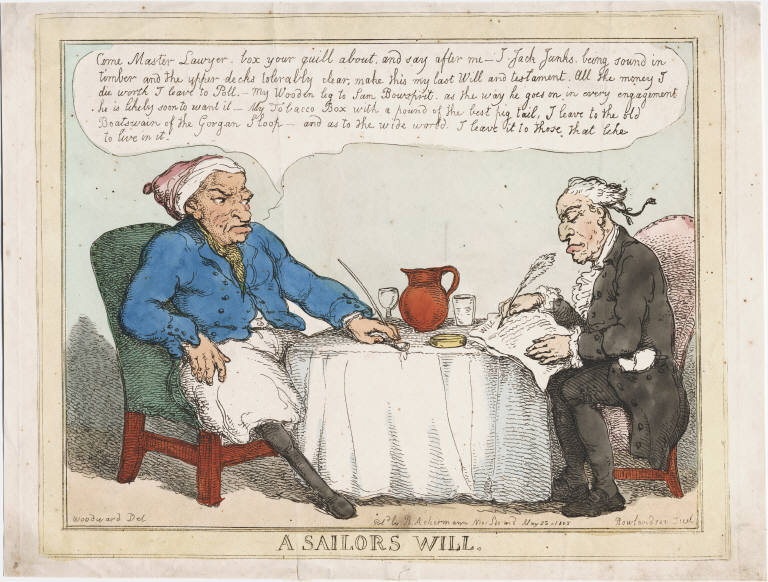Prerogative Court of Canterbury Wills (PCC)
 Woodward and Rowlandson, A Sailor's Will (1805). © Lewis Walpole Library.
Woodward and Rowlandson, A Sailor's Will (1805). © Lewis Walpole Library.
Introduction
This dataset includes abstracted details drawn from the registers of wills proved at the Prerogative Court of Canterbury between the 1st of January 1680 and the 31st of December 1819, which are available for searching by name, occupation, location and keyword. This dataset forms a fragment of the complete list of wills proven at Canterbury available from The National Archives for the period from 1384 to 1858. To search the full list and to access images of the original wills please refer to The National Archives. Copyright in this material remains with the original investigators and the National Archives, and this dataset is reproduced here by license, for non-commercial use only.
The dataset includes the testator's name, occupation and address (including parish and county or country), the date on which the will was proved, a unique identification number, and information about where in the register the original information is located.
The transcriptions from the originals were made between November 2001 and October 2003 by The National Archives.
The Prerogative Court of Canterbury (PCC)
The Prerogative Court of Canterbury (PCC) was a church court under the authority of the Archbishop of Canterbury, which was responsible for the probate of wills and trials of testamentary causes where the value of the goods involved was greater than five pounds, and the property was held in two (or more) dioceses within Great Britain. While wills might also be proven at York, Canterbury's jurisdiction covered Southern England (including London) and Wales. Its archive also contains large numbers of wills relating to individuals who died abroad, but who owned property in Britain. In the period between 1680 and 1820 the Court proved on average 3,700 wills a year, including large numbers of Irish and colonial wills, and those of soldiers and sailors who died while in service.
The source included in this database is the index to these wills rather than the wills themselves. The index was originally organised by year and by the initial letter of the testator's surname.
The Database
The original database was divided into fifteen fields, but where fields are blank or repeat information available in another field they have been suppressed in the version displayed here. Where information is available for each possible field the record will include:
- Unique Project ID: Unique identification number.
- Title: Professional or honorific title, such as Doctor or Sir.
- Forename
- Surname
- Occupation: A transcribed occupation reflecting eighteenth-century practice.
- Parish, County: A standardised parish and county name.
- Parish Name: A standardised parish name.
- County, or Country: A standardised county or country name.
- Date Proven: Date on which the will was accepted as legitimate by the court.
- TNA Item and Image ID: A unique ID number keyed to the original will held at the National Archives.
Within the London Lives website, this data is displayed in a tabular format. A typical entry (with blank fields suppressed) looks like:
- Catalogue ID: 2531407
- Forename: Domnick
- Surname: Donnelly
- Occupation: Mathematician
- Parish, County: Middle Temple, City of London
- Parish Name: Middle Temple
- County, or Country: City of London
- Date Proven: 25 February 1760
- TNA Item and Image ID: 500275
Back to Top | Introductory Reading
Using this Dataset in London Lives
Because proving a will at Canterbury was restricted to those able to leave five pounds or more, few people below the middling sort are included here. As a result, the names that appear in this dataset are unlikely to overlap significantly with the names of either recipients of poor relief or the perpetrators of crime. The only exception was that large numbers of serving soldiers and sailors, many of whom where quite poor, did leave a will. On the whole, testators' names are more likely to appear amongst the parish records associated with vestrymen and parish officers than with the recipients of relief. They will also be found among the jurymen who are listed in Westminster Coroners' Inquests (IC). In the Old Bailey Proceedings (OBP), they are likely to appear as jurymen, witnesses and victims of crime; and in the records of St Thomas's Hospital, they will be found among the governors in the Minutes of the Court of Governors (MG).
Testators are also likely to be found among several of the other additional datasets included in London Lives. In particular, matches will be found in the rate books and voting records in the Westminster Historical Database (WHD); the Fire Insurance Policy Registers, 1777-1786 (FIR); Income Tax Payments, 1799-1803 (ITP); the salary records of 'Clerks' of the East India Company, 1760-1820 (EIC); and the records of the London and Westminster Directory, 1774 (DIR).
Original Sources
The National Archives, Prerogative Court of Canterbury Wills, 1384-1858 [computer file]. Colchester, Essex: UK Data Archive [distributor], March 2004. SN: 4816. Will Registers: 2,263 volumes held at The National Archives.
Introductory Reading
- Scott, Miriam. Prerogative Court of Canterbury Wills and Other Probate Records. Kew, 1997.
- Grannum, Karen and Taylor, Nigel. Wills and Probate Records. Kew, 2009.
- Arkell, Tom, Evans, Nesta and Goose, Nigel, eds. When Death Do Us Part: Understanding and Interpreting the Probate Records of Early Modern England. Hatfield, 2000.
Online Resources
- Prerogative Court of Canterbury wills (1384 - 1858)
- UK Data Archive: Prerogative Court of Canterbury Wills, 1384-1858
For further reading on this subject see the London Lives Bibliography.